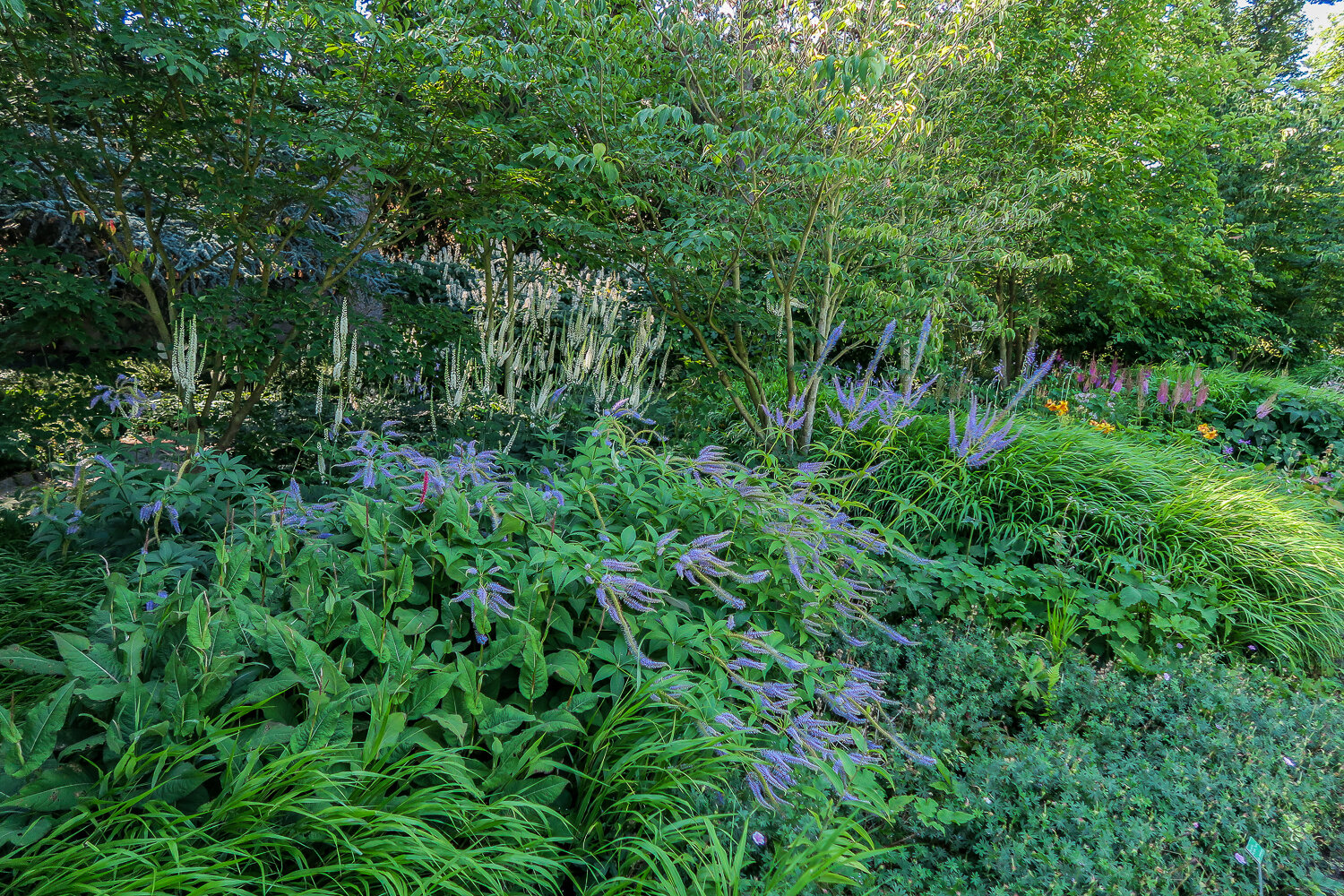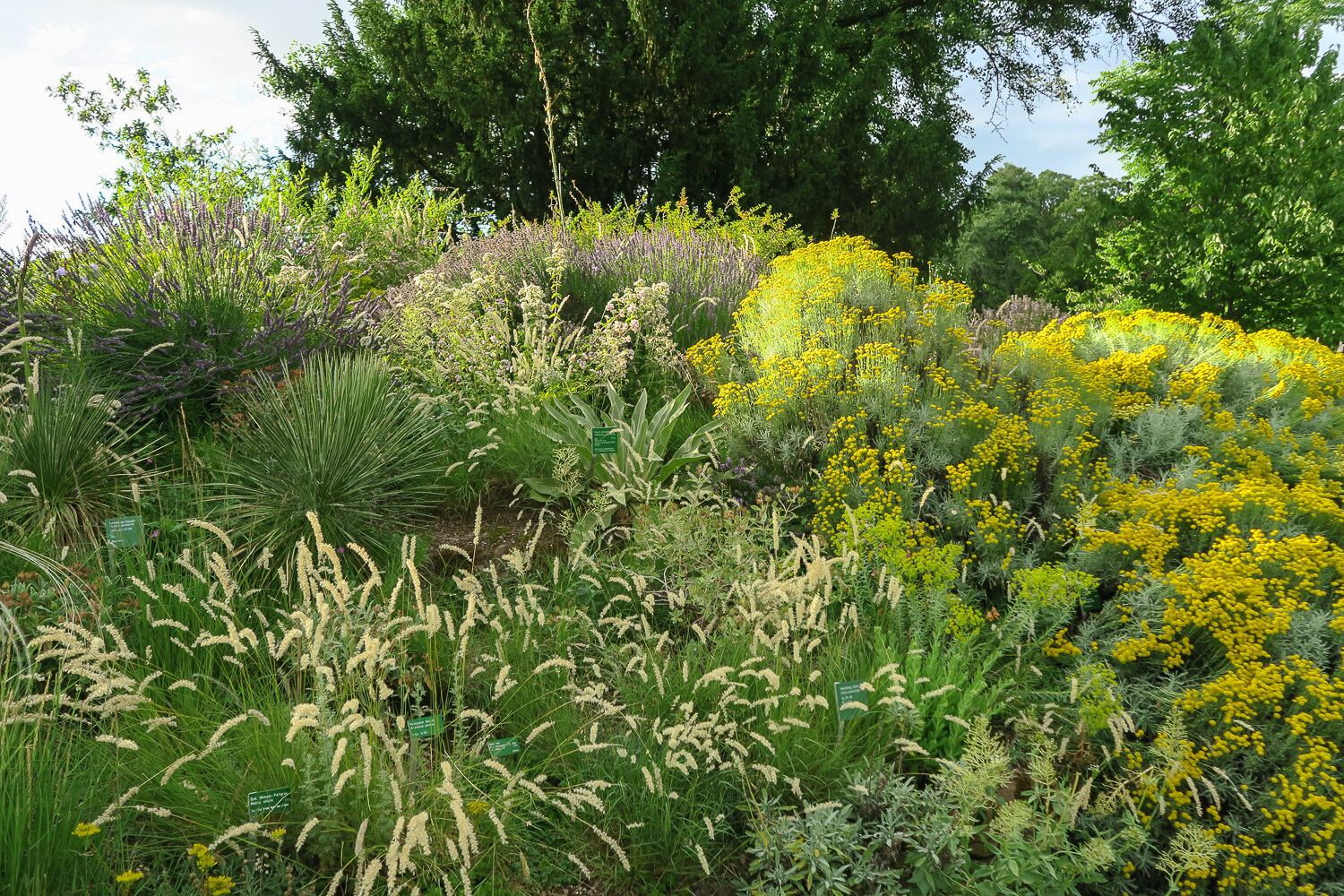A summer walk at Hermannshof—a garden celebrating the beauty of plants, their communities and habitats by Giacomo Guzzon

Here is another in a series of posts on landscape design by my friend Giacomo Guzzon, a landscape architect in London with a particular interest in the use of habitat-specific plantings to create resilient plant communities with a strong identity, character, and beauty. Hermannshof, of course, is an exemplar of this style. I had the opportunity to visit Hermannshof with Giacomo in 2019.
— James Golden, ed.
We all can use whatever relief we can find during these days of Covid, so last June, when the first severe lockdown had ended, I took the opportunity to visit my friends Cassian Schmidt and his wife Bettina Jaugstetter at the extraordinary garden, Hermannshof, in Weinheim, Germany, where Cassian is the director. I stopped by for a brief visit on my way to my family’s home in Italy. This blog post features photos from Hermannshof that I took on that visit.
WOODLAND/WOODLAND EDGE HABITATS
Woodland planting inspired by east Asian monsoon forest, with Hakonechloa macra, hosta, rodgersia, astilbe, aruncus, persicaria, and Hortensia paniculata 'Early Sensation'.
.
Woodland planting with Aesculus parviflora, hosta, Carex foliosissima 'Icedance', and Cimicifuga racemosa
The Schau und Sichtungsgarten Hermannshof is a renowned display and trial garden showcasing over 2500 taxa of plants arranged in naturalistic and habitat-specific plantings. It is a public garden privately owned by the Freudenberg industrialist family and founded by the city of Weinheim and the Freudenbergs. The garden has been under the guidance of Professor Cassian Schmidt for 21 years now, and has become an important place for study, research and display of visually appealing and characterful habitat-based plantings. Cassian travels extensively to observe plant communities in the wild, and these observations have a strong influence on his approach to design of plantings, both visually and ecologically.
Woodland plant community for moist soils with aruncus and bold foliage plants such as rodgersia and hosta, which define the character of this area.
Woodland edge planting between the Asian woodland and the lawn area. In this transitional area, in front of some large multi-stem Cornus, herbaceous species such as anemone, astilbe, aruncus, astrantia, cimicifuga, bistorta, veronicastrum, and hakhonechloa create a visually appealing plant community and share moist soil conditions in half-shade.
The garden is divided into several habitats–Lebensbereiche, in German—such as woodland, woodland edge, prairie, steppe, water’s edge and ‘flower bed’—as described by Richard Hansen and Friedrich Stahl in their now well-known book Perennials and their Garden Habitats. In the seventies, Gerda Gollwitzer, a landscape architect friend of the Freudenberg family, suggested the transformation of Hermannshof into an experimental garden inspired by Weihnstephan near Munich, which was led by Professor Richard Hansen. She introduced Hansen to Hermannshof, and he supported the idea of a trial garden focused on plantings in public spaces. Following this concept the garden was re-designed in collaboration with landscape architect Professor Hans Luz and Professor Urs Walser, a former student of Hansen. Walser, who became the first director of Hermannshof in the early eighties, designed the original plantings for the garden, emphasizing aesthetics as well as functionality. The goal was to create plant communities that are visually appealing and also best suited for various habitats and uses one might find in a variety of different gardens.
Another area with a woodland-edge plant community featuring two large specimens of Boehmeria japonica (in front) and B. platanifolia, a beautiful perennial plant from China with palmate leaves growing best in dappled shade in a moisture retentive soil.
Dysosma pleiantha 'Big Leaf' is an impressive woodland-woodland edge species from Hubei, Sichuan and Yunnan in China.
A shaded slope just next to the entrance features a robust plant community for dry soil under large existing trees, with Helleborus x sternii intermingled within a carpet of Carex alba. This sedge species, native to Europe, is a perfect ground-cover for dry shade.
The first time I entered the garden, I was immediately impressed by the botanical richness and sophistication of each garden area, and by how the meticulous selection of species appropriate to specific garden habitats gave a distinctive character to these spaces. I remember having been quite overwhelmed by this garden. It was not only beautiful but also very informative. It is a garden combining species labels, information boards, species lists, recommended densities and groupings, with beautiful compositions of plants. Unlike many other botanical gardens and parks I had visited before in Europe, most of which are either devoted exclusively to plant science, with rigorous botanical subdivisions but little consideration of aesthetics, or to amenity and other utilitarian needs, Hermannshof is different and unique. It is a garden that gives equal attention to botanical research and to beauty, while creating a place to experience, explore and feel completely immersed in the vegetation.
A woodland edge garden habitat area along the main path with Acer griseum and Acer davidii underplanted with Hemerocallis citrina, astantia, gernaium, convallaria and Euphorbia sarawschanica.
View of the central lawn from beneath the multi-stem evergreen Turner's oak, Quercus x turneri 'Pseudoturneri', under-planted with a large colony of Polygonatum x hybridum ‘Weihenstephan’, a very robust and drought tolerant species.
After my first visit in 2015, when my friend Austin Eischeid introduced me to Hermannshof, many more visits followed almost every year. These visits also allowed me to get to know and become friends with Cassian and Bettina, who is a well-known landscape architect in her own right, Ulli Battmer, the former head-gardener at Hermannshof, and Harald Sauer, a landscape designer of growing prominence I met through Cassian. Working for the city of Ludwishafen, Harald has gained a reputation for design of large habitat-based plantings in public spaces.
View of the central lawn from the opposite side of the open space, where a multi-stem Malus hupehensis is underplanted with Boehmeria platanifolia 'Lushan' and Calamagrostis arundinacea 'Lushan'. In this location the Boehmeria receives a generous amount of sun, showing us its adaptability and broad ecological amplitude.
The area underneath a large Cedrus atlantica at the western end of the garden is planted with a large swathe of green-leaved hosta and a carpet of Sesleria autumnalis with groups of Iris foetidissima dotted in. Sesleria and Iris foetidissima are both tolerant of dappled shade and dry soils.
In the dappled shade underneath a large Ginkgo biloba, Epimedium x perralchicum 'Frohnleiten' creates a dense cover. This epimedium is evergreen and probably one of the best ground-covers of this genus.
MOIST MEADOW HABITATS
Moist meadow planting viewed from the shade of a multi-stem Cedrus atlantica.
The moist meadow area around the pond which is located at the bottom of the central lawn. This plant community features many large late-flowering perennials native to North American wet meadows. Some species characterizing this designed plant community are Iris sibirica, Euphorbia palustris, Bistorta officinalis, Hemerocallis middendorfii, Alchemilla mollis, Tradescantia , Veronica longifolia, Veronicastrum, and Molinia arundiacea.
Hemerocallis citrina, a very elegant day-lily, tolerates both sunny and half shady areas, showing a broad ecological amplitude.
A moist meadow planting in May with Camassia, Narcissus poeticus var. recurvus, and Euphorbia palustris flowering simultaneously.
DRY STEPPE HILLSIDE AND GARRIGUE HABITAT
A dry steppe hillside planting with Melica ciliata, Stipa pulcherrima var. nudicostata, Galium verum, and Euphorbia segueriana var. niciciana all growing in a raised bed with dry and free draining soil.
The inflorescences of melica and stipa catching the low evening light.
The dry steppe hillside planting continues into a Mediterranean garrigue-inspired planting with santolina, lavandula, stipa and melica.
Planting community for dry and free draining soil.
PRAIRIE HABITAT
The dry meadow area with early flowering perennials and grasses of southern European origin such as Achillea filipendulina, Verbascum densiflorum, Pseudolysimachion longifolium, Salvia nemorosa, Salvia grandiflora, Salvia sclarea, Salvia verticillata, Phlomis russeliana, Knautia macedonica, Lychnis coronaria, Festuca mairei, Stipa splendens and Chrysopogon gryllus.
Another plant community for a dry and sunny site. In this area peonies are intermingled with Stipa tenuissima and Lilium regale.
The American prairie planting with many summer flowering perennials such as Echinacea pallida, Asclepias tuberosa, Verbesina helianthoides, Silphium perfoliatum, Parthenium integrifolium, and Monarda menthifolia.
Echinacea pallida catching the late evening light.























